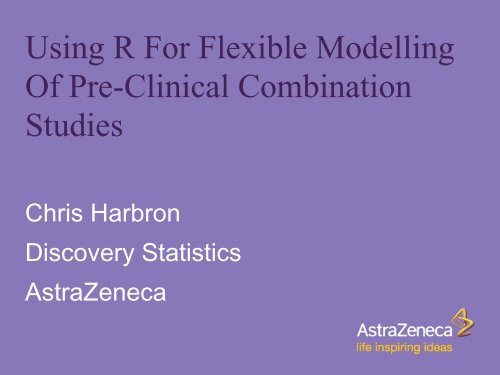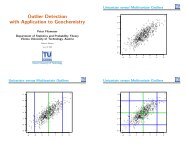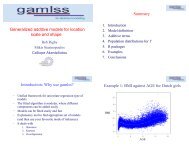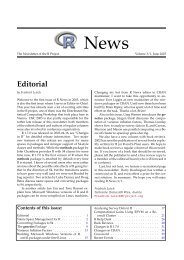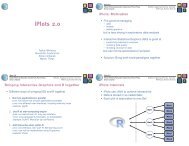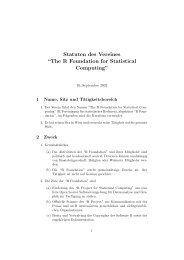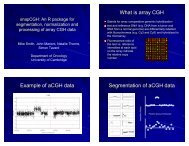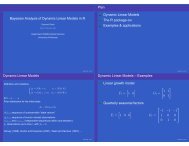Using R For Flexible Modelling Of Pre-Clinical Combination Studies
Using R For Flexible Modelling Of Pre-Clinical Combination Studies
Using R For Flexible Modelling Of Pre-Clinical Combination Studies
You also want an ePaper? Increase the reach of your titles
YUMPU automatically turns print PDFs into web optimized ePapers that Google loves.
<strong>Using</strong> R <strong>For</strong> <strong>Flexible</strong> <strong>Modelling</strong><br />
<strong>Of</strong> <strong>Pre</strong>-<strong>Clinical</strong> <strong>Combination</strong><br />
<strong>Studies</strong><br />
Chris Harbron<br />
Discovery Statistics<br />
AstraZeneca
<strong>Modelling</strong> Drug <strong>Combination</strong>s<br />
• Why?<br />
• The theory<br />
• An example<br />
• The practicalities in R<br />
AstraZeneca Discovery Statistics<br />
2 Chris Harbron, <strong>Using</strong> R <strong>For</strong> <strong>Flexible</strong> <strong>Modelling</strong> <strong>Of</strong> <strong>Pre</strong>-<strong>Clinical</strong> <strong>Combination</strong> <strong>Studies</strong>, USE-R 2009
Why Drug <strong>Combination</strong>s?<br />
• Making better use of our assets<br />
• Some marketed compounds are combinations e.g.<br />
Symbicort<br />
• In some disease areas, e.g oncology, HIV,<br />
polypharmacy is the norm<br />
• Compounds licensed only for use in combination<br />
with a specific other agent<br />
• Lapatinib (GSK – Breast cancer) is approved for use in<br />
combination with capecitabine<br />
• Increased molecular & pathway level understanding<br />
• Hypothesise and understanding synergistic actions<br />
• Link with systems biology<br />
AstraZeneca Discovery Statistics<br />
3 Chris Harbron, <strong>Using</strong> R <strong>For</strong> <strong>Flexible</strong> <strong>Modelling</strong> <strong>Of</strong> <strong>Pre</strong>-<strong>Clinical</strong> <strong>Combination</strong> <strong>Studies</strong>, USE-R 2009
<strong>Combination</strong> <strong>Studies</strong><br />
[B]<br />
[A]<br />
AstraZeneca Discovery Statistics<br />
4 Chris Harbron, <strong>Using</strong> R <strong>For</strong> <strong>Flexible</strong> <strong>Modelling</strong> <strong>Of</strong> <strong>Pre</strong>-<strong>Clinical</strong> <strong>Combination</strong> <strong>Studies</strong>, USE-R 2009
<strong>Combination</strong> <strong>Studies</strong><br />
[B]<br />
Benefit? : Better than monotherapy<br />
Synergy? : More effect than expected<br />
[A]<br />
AstraZeneca Discovery Statistics<br />
5 Chris Harbron, <strong>Using</strong> R <strong>For</strong> <strong>Flexible</strong> <strong>Modelling</strong> <strong>Of</strong> <strong>Pre</strong>-<strong>Clinical</strong> <strong>Combination</strong> <strong>Studies</strong>, USE-R 2009
Assessing Synergy<br />
Loewe Additivity<br />
IC70<br />
IC50<br />
IC30<br />
Based around “sham synergy”<br />
or “self synergy”<br />
A combination of a compound<br />
with itself should give the same<br />
effect as a monotherapy at the<br />
sum of the doses.<br />
Effect<br />
Contours<br />
IC30 IC50 IC70<br />
AstraZeneca Discovery Statistics<br />
6 Chris Harbron, <strong>Using</strong> R <strong>For</strong> <strong>Flexible</strong> <strong>Modelling</strong> <strong>Of</strong> <strong>Pre</strong>-<strong>Clinical</strong> <strong>Combination</strong> <strong>Studies</strong>, USE-R 2009
Interaction Index – Berenbaum<br />
<strong>Combination</strong> Index – Chou & Talalay<br />
IC70<br />
IC50<br />
IC30<br />
τ =<br />
d<br />
A +<br />
D<br />
A<br />
d<br />
D<br />
IC30 IC50 IC70<br />
B<br />
B<br />
Doses in<br />
<strong>Combination</strong><br />
ICx’s for the<br />
two compounds<br />
where x is the<br />
response<br />
shown by the<br />
combination<br />
AstraZeneca Discovery Statistics<br />
7 Chris Harbron, <strong>Using</strong> R <strong>For</strong> <strong>Flexible</strong> <strong>Modelling</strong> <strong>Of</strong> <strong>Pre</strong>-<strong>Clinical</strong> <strong>Combination</strong> <strong>Studies</strong>, USE-R 2009
Interaction Index – Berenbaum<br />
<strong>Combination</strong> Index – Chou & Talalay<br />
IC70<br />
IC50<br />
IC30<br />
τ<br />
τ<br />
d +<br />
d<br />
τ =<br />
A B<br />
DA<br />
DB<br />
= fraction of expected dose,<br />
assuming additivity, required to have<br />
same effect<br />
IC30 IC50 IC70<br />
AstraZeneca Discovery Statistics<br />
8 Chris Harbron, <strong>Using</strong> R <strong>For</strong> <strong>Flexible</strong> <strong>Modelling</strong> <strong>Of</strong> <strong>Pre</strong>-<strong>Clinical</strong> <strong>Combination</strong> <strong>Studies</strong>, USE-R 2009
Interaction Index – Berenbaum<br />
<strong>Combination</strong> Index – Chou & Talalay<br />
IC70<br />
IC50<br />
IC30<br />
d +<br />
d<br />
τ =<br />
A B<br />
DA<br />
DB<br />
τ < 1<br />
τ =1<br />
τ >1<br />
IC30 IC50 IC70<br />
Synergy<br />
Additivity<br />
Antagonism<br />
AstraZeneca Discovery Statistics<br />
9 Chris Harbron, <strong>Using</strong> R <strong>For</strong> <strong>Flexible</strong> <strong>Modelling</strong> <strong>Of</strong> <strong>Pre</strong>-<strong>Clinical</strong> <strong>Combination</strong> <strong>Studies</strong>, USE-R 2009
Interaction Indices<br />
• Wish to calculate these:<br />
• With standard errors / confidence intervals<br />
• Statements of confidence – significance tests<br />
• Use more flexibly and powerfully<br />
• Combining combination doses together<br />
• Overall assessments of synergy<br />
• Covering a wide variety of situations<br />
• Inactive agent<br />
• Partial Response Agent<br />
• Multiple Plates / Experiments<br />
AstraZeneca Discovery Statistics<br />
10 Chris Harbron, <strong>Using</strong> R <strong>For</strong> <strong>Flexible</strong> <strong>Modelling</strong> <strong>Of</strong> <strong>Pre</strong>-<strong>Clinical</strong> <strong>Combination</strong> <strong>Studies</strong>, USE-R 2009
Unified Tau<br />
⎧ d<br />
⎪ D<br />
⎪<br />
1 = ⎨d<br />
A<br />
⎪ τ<br />
( i<br />
⎪<br />
⎩ DA<br />
A<br />
A<br />
)<br />
+<br />
+<br />
d<br />
D<br />
d<br />
B<br />
B<br />
B<br />
τ<br />
D<br />
B<br />
( i)<br />
d<br />
d<br />
A<br />
A<br />
and<br />
• Where τ (i) is either:<br />
• a constant – response surface<br />
• (with discontinuities at the axes)<br />
• a separate value for each point<br />
• Berenbaum’s interaction index<br />
• a separate value for each ray (segment)<br />
• a separate value for each dose level of a compound<br />
• could fit tau as a continuous function of dose or ray<br />
or<br />
d<br />
B<br />
d<br />
B<br />
=<br />
><br />
0<br />
0<br />
Monotherapies<br />
<strong>Combination</strong>s<br />
AstraZeneca Discovery Statistics<br />
11 Chris Harbron, <strong>Using</strong> R <strong>For</strong> <strong>Flexible</strong> <strong>Modelling</strong> <strong>Of</strong> <strong>Pre</strong>-<strong>Clinical</strong> <strong>Combination</strong> <strong>Studies</strong>, USE-R 2009
An Example<br />
Monotherapies<br />
<strong>Combination</strong>s<br />
AstraZeneca Discovery Statistics<br />
12 Chris Harbron, <strong>Using</strong> R <strong>For</strong> <strong>Flexible</strong> <strong>Modelling</strong> <strong>Of</strong> <strong>Pre</strong>-<strong>Clinical</strong> <strong>Combination</strong> <strong>Studies</strong>, USE-R 2009
EDA Suggests Synergy<br />
At Higher Doses <strong>Of</strong> Drug A<br />
AstraZeneca Discovery Statistics<br />
13 Chris Harbron, <strong>Using</strong> R <strong>For</strong> <strong>Flexible</strong> <strong>Modelling</strong> <strong>Of</strong> <strong>Pre</strong>-<strong>Clinical</strong> <strong>Combination</strong> <strong>Studies</strong>, USE-R 2009
Identify Individual <strong>Combination</strong>s<br />
Significantly Demonstrating Synergy<br />
AstraZeneca Discovery Statistics<br />
14 Chris Harbron, <strong>Using</strong> R <strong>For</strong> <strong>Flexible</strong> <strong>Modelling</strong> <strong>Of</strong> <strong>Pre</strong>-<strong>Clinical</strong> <strong>Combination</strong> <strong>Studies</strong>, USE-R 2009
Estimates <strong>Of</strong> Synergy With 95% CIs<br />
Overall & <strong>For</strong> Different Dose Levels<br />
AstraZeneca Discovery Statistics<br />
15 Chris Harbron, <strong>Using</strong> R <strong>For</strong> <strong>Flexible</strong> <strong>Modelling</strong> <strong>Of</strong> <strong>Pre</strong>-<strong>Clinical</strong> <strong>Combination</strong> <strong>Studies</strong>, USE-R 2009
Fitting in R<br />
fit
Flexibly Building <strong>For</strong>mula<br />
Varying number of combination parameters to be fit:<br />
as.formula(paste(“resp ~ tau.model(parameters,<br />
paste("logtau" , 1:ntaus , sep="" , collapse=","),<br />
“gp= c(",paste(groupindex,collapse=",") ,<br />
“))” ))<br />
• Build as a text string, then convert to a formula<br />
• Varying numbers of tau parameters<br />
• Convert group index vector into a text string in the<br />
right format<br />
AstraZeneca Discovery Statistics<br />
17 Chris Harbron, <strong>Using</strong> R <strong>For</strong> <strong>Flexible</strong> <strong>Modelling</strong> <strong>Of</strong> <strong>Pre</strong>-<strong>Clinical</strong> <strong>Combination</strong> <strong>Studies</strong>, USE-R 2009
Iterative Fitting of <strong>For</strong>mula<br />
Iterative Non-linear curve-fitting performed by nls() :<br />
monotherapy and tau parameters<br />
tau.model(d 1 ,d 2 ,m 1 ,m 2 ,lower 1 ,lower 2 ,ldm 1 ,ldm 2 ,taus)<br />
<strong>For</strong> each observation :<br />
Make initial estimate of Y<br />
Calculate D 1 & D 2 –<br />
monotherapies required to achieve Y using Hill equation<br />
Adjust Y up or down depending on whether<br />
d1<br />
d2<br />
τ<br />
( i)<br />
τ<br />
( i)<br />
+ is >1 or < 1<br />
D D<br />
18 Chris Harbron, <strong>Using</strong> R <strong>For</strong> <strong>Flexible</strong> <strong>Modelling</strong> <strong>Of</strong> <strong>Pre</strong>-<strong>Clinical</strong> <strong>Combination</strong> <strong>Studies</strong>, USE-R 2009<br />
1<br />
Iterate until Y is accurately estimated<br />
Based on code developed by Lee et al<br />
2<br />
AstraZeneca Discovery Statistics
mynls() : A less temperamental nls()<br />
Parameter Estimates<br />
Calculate Deviance<br />
Calculate Direction<br />
Calculate Test Parameters<br />
=Estimates + Factor * Direction<br />
Calculate New Deviance<br />
Reduced<br />
Deviance?<br />
Estimates = Test Parameters<br />
N<br />
Half<br />
Factor<br />
AstraZeneca Discovery Statistics<br />
19 Chris Harbron, <strong>Using</strong> R <strong>For</strong> <strong>Flexible</strong> <strong>Modelling</strong> <strong>Of</strong> <strong>Pre</strong>-<strong>Clinical</strong> <strong>Combination</strong> <strong>Studies</strong>, USE-R 2009
mynls() : A less temperamental nls()<br />
Parameter Estimates<br />
Calculate Deviance<br />
Calculate Direction<br />
Calculate Test Parameters<br />
=Estimates + Factor * Direction<br />
Calculate New Deviance<br />
Reduced<br />
Deviance?<br />
Estimates = Test Parameters<br />
This cannot be<br />
calculated from<br />
unrealistic<br />
parameter<br />
estimates.<br />
tau.model() fails to fit<br />
N<br />
Half<br />
Factor<br />
AstraZeneca Discovery Statistics<br />
20 Chris Harbron, <strong>Using</strong> R <strong>For</strong> <strong>Flexible</strong> <strong>Modelling</strong> <strong>Of</strong> <strong>Pre</strong>-<strong>Clinical</strong> <strong>Combination</strong> <strong>Studies</strong>, USE-R 2009
mynls() : A less temperamental nls()<br />
Parameter Estimates<br />
Calculate Deviance<br />
Calculate Direction<br />
Calculate Test Parameters<br />
=Estimates + Factor * Direction<br />
Calculate New Deviance<br />
Calculated & Reduced<br />
Deviance?<br />
Estimates = Test Parameters<br />
N<br />
Extra error<br />
check prevents<br />
crashing when<br />
iterative<br />
algorithm steps<br />
too far<br />
Half<br />
Factor<br />
AstraZeneca Discovery Statistics<br />
21 Chris Harbron, <strong>Using</strong> R <strong>For</strong> <strong>Flexible</strong> <strong>Modelling</strong> <strong>Of</strong> <strong>Pre</strong>-<strong>Clinical</strong> <strong>Combination</strong> <strong>Studies</strong>, USE-R 2009
Starting Parameters<br />
• Good starting parameters from fitting marginal<br />
distributions (e.g. monotherapies) and direct<br />
calculations<br />
• In some situations, this can be done exactly, so nls()<br />
converges immediately to the starting parameters, but with<br />
standard errors added<br />
• Starting from multiple starting points decrease risks<br />
of local minima<br />
• Identify and fix parameters likely to shoot off to<br />
infinity beforehand<br />
AstraZeneca Discovery Statistics<br />
22 Chris Harbron, <strong>Using</strong> R <strong>For</strong> <strong>Flexible</strong> <strong>Modelling</strong> <strong>Of</strong> <strong>Pre</strong>-<strong>Clinical</strong> <strong>Combination</strong> <strong>Studies</strong>, USE-R 2009
Summary<br />
• Early identification of synergistic drug combinations<br />
of strategic importance within the pharmaceutical<br />
industry<br />
• Powerful and flexible methodology for identifying and<br />
characterising synergy<br />
• R provides a powerful environment for fitting and<br />
visualising these models<br />
• Careful programming increases the of robustness<br />
and success rate of R in fitting these models<br />
AstraZeneca Discovery Statistics<br />
23 Chris Harbron, <strong>Using</strong> R <strong>For</strong> <strong>Flexible</strong> <strong>Modelling</strong> <strong>Of</strong> <strong>Pre</strong>-<strong>Clinical</strong> <strong>Combination</strong> <strong>Studies</strong>, USE-R 2009


